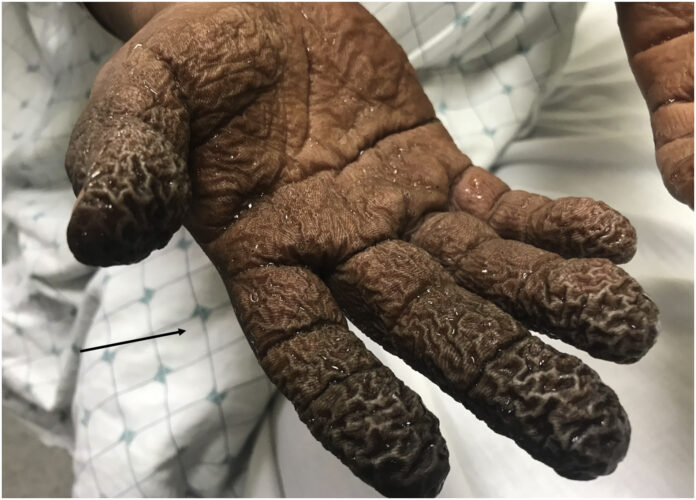A 33-year-old male presented with severe burning in his hands due to chemical burn while handling paint thinner (Klean-Strip) without using gloves or any protective layer
A 33-year-old male presented to the Emergency Department with a chemical burn to both hands while handling paint thinner (Klean-Strip) without using gloves or any protective layer. The patient had been in contact with the culprit agent for almost 7 hours. He reported a severe burning sensation involving his entire palms and fingers bilaterally.
Klean-Strip is a powerful stripper comprising of Stoddard solvent, a petroleum-derived mixture of organic hydrocarbons. It is classified as a hazardous material under Occupational Safety and Health Administration (OSHA) regulations.
Examination revealed discoloured and waxy palms. Moreover, the emergency physician noticed a leather-like texture, especially on his fingertips.
Burns with organic solvents, particularly hydrocarbons, can cause corrosive dissolution of lipids. Klean strip on exposure to skin may cause irritation, numbness, tingling, dermatitis, and skin dryness. Prolonged exposure can lead to the dissolution of the fat layer. Chemical burns are different from thermal burns. Thermal burns cause local tissue denaturation, subsequently releasing local inflammatory mediators due to an exothermic reaction. Chemical agents, particularly the organic solvents, as seen in this case, dissolve in lipids and have a solvent action on cell membranes. The outcome can be fatal too.
The key to managing patients with chemical burns is reducing the exposure time and limiting the ongoing injury. The first and foremost step is to remove the culprit agent as soon as possible. Remove all the clothing and jewellery around the affected area (decontamination), followed by flushing the affected skin with water. Most chemical burns benefit from water flushing; however, certain chemical compounds should not be washed off with water. Moreover, one should not forget the indirect injuries that can result secondary to a collection of the culprit chemical in physically constrained areas covered by clothing such as the beltline and socks.
A head-to-toe examination remains indispensable to detect if there are more injuries other than the primary site. Moreover, during rinsing the primary site, the chemical may involve other parts of the body. Therefore, a thorough general physical examination is imperative.
Can you use tap water to rinse the chemical burn?
It is not necessary to use saline or distilled water. You can use tap water to rinse the involved skin provided the water is at room temperature (close to the normal body temperature).
Which chemicals should not be washed with water?
Avoid water rinsing the following chemical burns:
- Carbolic acid or phenol. First, use rubbing alcohol to flush the chemical (except the eye), then irrigate the skin with water.
- Sulfuric acid needs flushing with a mild, soapy solution.
- Dry powders should be brushed away first, then only flush with water for 20 minutes.
- Metal compounds.
How long should you rinse with water?
Acidic burns need irrigation for up to 30 minutes.
Alkali (base) burns need irrigation till the patient reaches the hospital. Even in the hospital, irrigation should continue till the treating team can perform a pH assessment.




